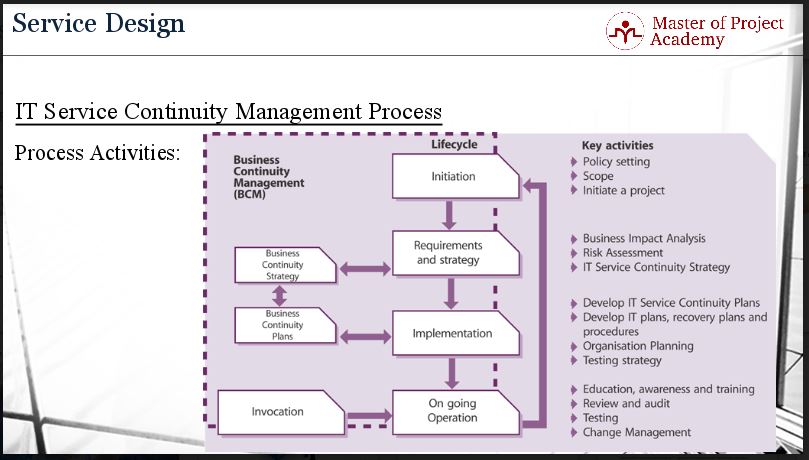IT Service Continuity Management is the final process of the Service Design Stage of the ITIL Service Lifecycle as defined also in online free ITIL courses. It’s important to understand the overall goal of IT Service Continuity Management and its objectives and processes in relation to the business’s mission and vision. Without IT Service Continuity Management, the ITIL Service Design stage cannot be completed and the ITIL Service Transition stage cannot start.

The goal of IT Service Continuity Management
The main goal of the IT Service Continuity Management process is supporting the overall business continuity management. A further goal of the IT service provider is providing its services to the business or customer to ensure the mission or vision of the business or customer. In this way, business continuity is ensured and this is supported by the IT Service Continuity Management process.
IT Service Continuity is provided by the IT service provider by ensuring that the required IT technical and service facilities can be resumed within the required and agreed business timescales. This means that the IT Service provider must assure that the agreed service levels and targets are met. For instance, if a bank provides money transfer service for its customers from nine a.m in the morning to four p.m in the evening, the IT service provider has to ensure this continuity for the sake of the business continuity.
The Objectives of IT Service Continuity Managment
Maintaining IT Service Continuity Plans and IT Recovery plans
The first objective is maintaining a set of IT Service Continuity Plans and IT Recovery Plans. As described in ITIL training, business continuity must be aligned with the vision and mission of a company. And this is ensured by IT service continuity plans on IT service provider side. If a bank aims to provide money transfer services from nine a.m in the morning till four p.m in the evening, this must be ensured by IT service provider and this is planned and documented in IT service continuity plans.
Note that, IT service continuity also covers IT Recovery. For instance, what will the course of actions be if money transfer stops, or if one of the servers providing money transfer service corrupts? The steps that must be followed to recover an outage or a problem with a service are documented in IT Recovery Plans.

Complete Business Impact Analysis
The second objective is completing regular Business Impact Analysis. Business impact analysis is done to see what the impact of an outage or problem in a service is in the business. For instance, if a money transfer service of a bank is provided with two databases and two servers, what will be the impact on the money transfer service if one of the databases corrupt or if one of the servers goes down? Or what happens if a service is used by more than its capacity? What will the size of degradation be on service quality? These kinds of analysis are done during business impact analysis.
Provide Guidance on All Service Continuity and Recovery Related Issues
Since IT Service Continuity Management maintains IT service continuity and recovery plans, the IT Service Continuity Management process also provides advice and guidance on all continuity or recovery related issues. There might be problems or issues related to ensure the required business continuity or recovery for the provided services in an IT service provider. This process aims to provide advice and guidance on these issues.
Assess the Impact of All Changes on the IT Service Continuity and IT Recovery Plans
And as the last objective, the IT Service Continuity Management process assesses the impact of all changes on the IT service continuity plans and IT recovery plans. For instance, if the business requirements are to increase hours of operation for a service, or aims to reduce the recovery time for a service in case of a failure, these all require updates and changes in existing IT service continuity plans and IT recovery plans respectively.
IT Service Continuity Managment Process Activities.
This figure describes the process activities of IT Service Continuity Management process. The first step is the initiation in the service lifecycle. Key activities at the initiation step are policy settings, scope, and initiation of the project. The policies of a company cover service design, usage, implementation, security, availability, capacity and many other areas as well. These policies define how service management will be done by an IT service provider. Based on the business and customer requirements, the scopes of the projects are defined. After the scope is determined, projects are initiated to implement the determined scope.

In the next step, requirements and strategy are evaluated. Business impact analysis, risk assessment activities are done and an IT Service continuity strategy is developed respectively. Business impact analysis helps to see the outcomes of an unexpected or emergency situation. In this way, the IT service provider can create plans to overcome the outages or problems in case of service outage or degradation. Risk assessment helps to identify the impact and probability of risks. This helps to prioritize the risks. And the IT Service Continuity strategy is the outer circle of this concept. With this strategy, the IT service provider aims to ensure the required service availability, capacity, and quality of the business and customers who will use the provided services.
After the requirements and strategy steps, implementation step takes place. During this step, IT service continuity plans, IT plans and recovery plans are developed in order to come back into operation whenever an outage or service degradation occurs. Organization planning and testing strategies are shaped during this step. In order to check whether the developed services will meet the required service level targets, tests are conducted before providing services for the use of customers. Note that, the second and third steps are executed in parallel with the business continuity strategy and business continuity plans.
And finally, if all developed and tested services meet the required service levels, the fourth and the last step starts ongoing operation. This step includes education, awareness, and training of the employees on the services, policies, and procedures. In order to provide a service and support the customers, trained professionals and personnel is a must. Reviews and audits also take place in this step to monitor whether the actual performance of the services meets the expectations or targeted levels. If there will be updates or new requirements from the customers, these are evaluated in the context of change management during ongoing operation step.
IT Service Continuity Management is an important part of ITIL Service Management. Service owners must be fully aware of the goals, objectives, and processes that encompass IT Service Continuity Management in order to manage IT service effectively in alignment with business objectives.
Review by: Jamie Brooks

One thought on “Service Continuity Management: Ensure the Lasting Quality of IT Services”
Comments are closed.